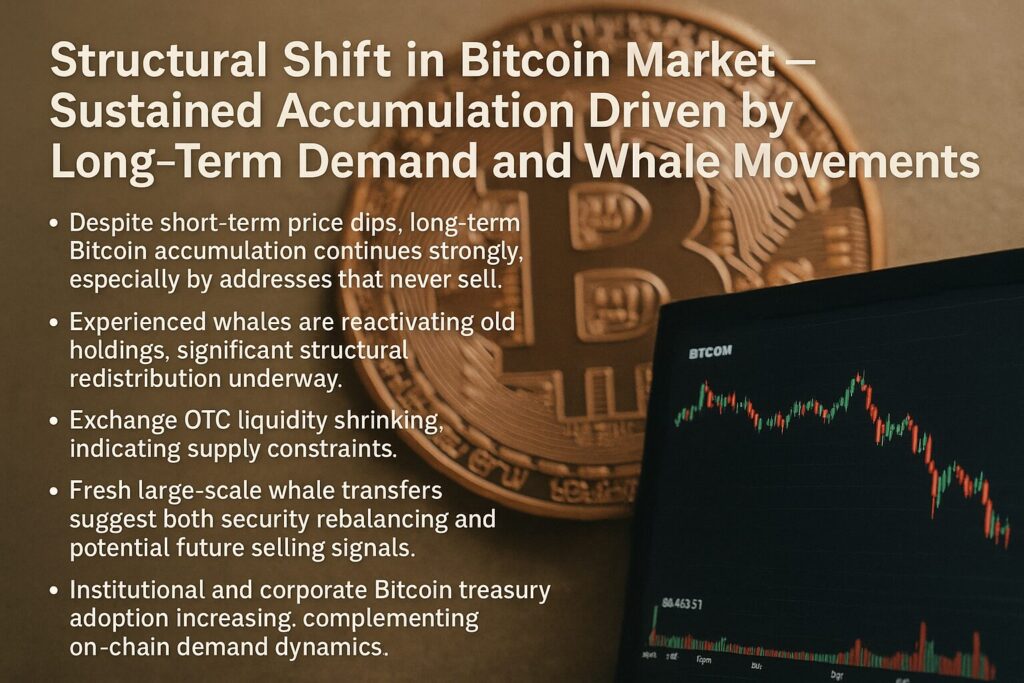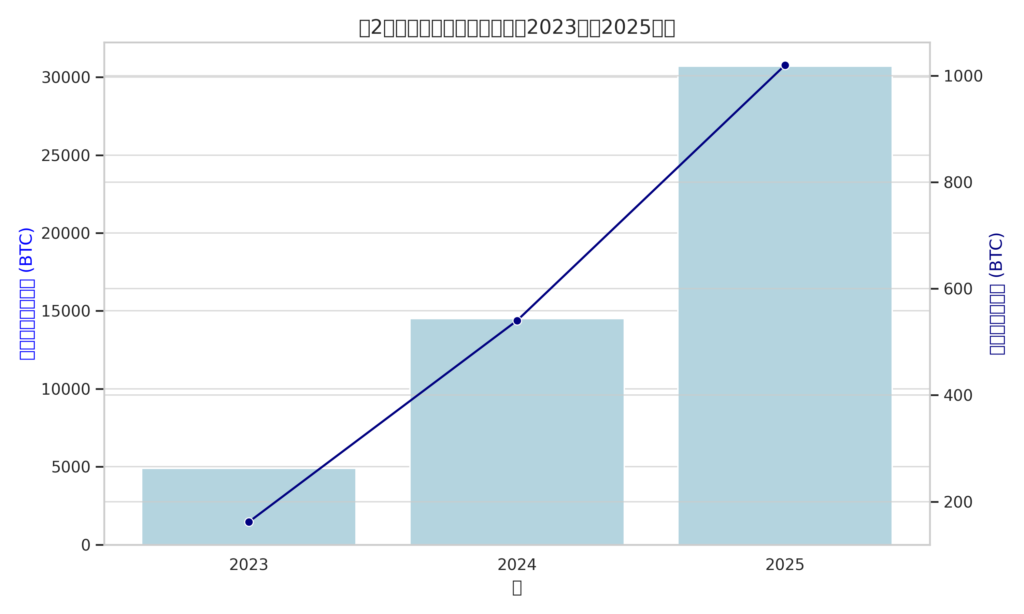
Main Points :
- Despite short‑term price dips, long‑term Bitcoin accumulation continues strongly, especially by addresses that never sell.
- Experienced whales are reactivating old holdings, significant structural redistribution underway.
- Exchange OTC liquidity shrinking, indicating supply constraints.
- Fresh large-scale whale transfers suggest both security rebalancing and potential future selling signals.
- Institutional and corporate Bitcoin treasury adoption increasing, complementing on‑chain demand dynamics.
1. Market Structure Evolution: Persistent Demand Beyond Price Action
On‑chain analysis from CryptoQuant shows that although Bitcoin recently dropped ~2–4%—from mid‑July all‑time highs of around $108 K–$110 K down to ~$103 K–$115 K—demand metrics remain firmly positive. Long‑term holder demand continues to outpace new issuance: in early August, ~160,000 BTC were added to accumulation wallets over the past 30 days versus only ~13,500 BTC mined in that period—an 11:1 demand‑to‑supply ratio.

These “accumulator” addresses added roughly 50,000 BTC on average over one month, signalling strategic, belief‑driven accumulation rather than speculative trading.
2. Whale Dynamics and Reactivation of Dormant Supply
On‑chain whale activity has accelerated dramatically. Monthly average BTC moved by whales rose from ~4,900 BTC in 2023 to ~30,700 BTC by 2025, and average transaction size increased from ~162 BTC to over 1,000 BTC per move—indicating institutional or organized capital redistribution rather than retail behavior.
Notably, in July 2025, eight Satoshi‑era wallets—each originally holding ~10,000 BTC—were activated, moving ~80,000 BTC in total. Subsequently ~28,600 BTC (worth over $3B) were sent to Galaxy Digital, of which ~9,000 BTC has been sold so far, coinciding with a ~5% price drop from a peak near $123 K.
Also, after 12.4 years of inactivity, a dormant wallet moved 306 BTC (~$35M), likely reflecting routine re‑organization or security upgrades, rather than immediate liquidation.
3. Shrinking Offline Liquidity: OTC Desk Balance Decline
Data shows OTC desk holdings have fallen sharply—from around 550,000 BTC available in 2021‑09 to approximately 145,000 BTC now—implying less readily available supply for large trades. This suggests constrained liquidity and supports bullish medium‑term price posture.
4. Institutional and Corporate Adoption Reinforces On‑Chain Demand
Bitcoin’s legitimacy as a treasury asset has grown. U.S. spot Bitcoin ETFs launched in 2024, with cumulative flows hitting ~$15B in recent months; BlackRock’s iShares Bitcoin Trust (IBIT) has amassed close to $80 B in assets under management—the fastest growth among asset classes.
Major corporations and public entities are allocating BTC in place of cash reserves—Global trend toward crypto reserves gaining traction. U.S. government initiated a strategic Bitcoin reserve in March 2025, holding approx. 200,000 BTC—demonstrating official adoption.
Deutsche Bank analysts identify five structural signals of maturity: regulatory support, institutional inflows, treasury adoption, de‑dollarization trends, and technological scalability improvements—all pointing to Bitcoin’s integration into mainstream finance.
5. Emerging Risk Signals from Whale Behavior and On‑Chain Patterns
While accumulation remains strong, whale movements also bring mixed signals. Massive reactivations of long‑dormant supply may foreshadow distribution ahead of price corrections—such as early July’s 80,000 BTC being reactivated before sales to Galaxy Digital.

Chainalysis reports crypto theft continues to increase; over $2.17 B in assets stolen so far in 2025, raising concerns around security and risk management for institutional participants. Analysts caution that while on‑chain data offers transparency, broader fundamentals and regulatory developments must also be considered to gauge market trajectory accurately.
Summary
The Bitcoin market is undergoing a significant structural shift: long‑term accumulation driven by conviction, coupled with shrinking exchange and OTC liquidity, is underpinning a broader bull case. Meanwhile, whale activity—including large-scale reactivations of dormant supply—reflects both potential signals of rebalancing and latent distribution risk. Institutional adoption and corporate treasury accumulation further reinforce demand dynamics. Nonetheless, vigilance is required: big whale moves and heightened security risks remind us that on‑chain patterns are only part of a complex market context.

